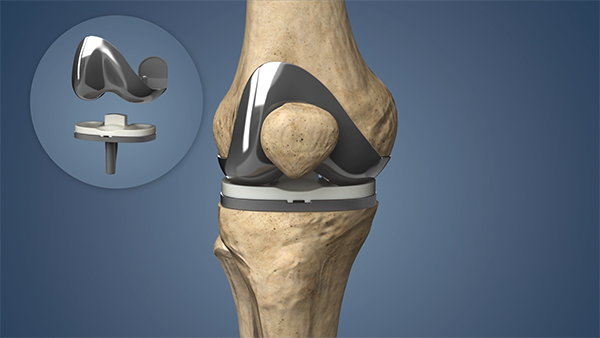Prothèse totale de genou (PTG) - FAQ
You will find the answers to the frequently asked questions (FAQ) concerning your total knee replacement.
You will find the answers to the frequently asked questions (FAQ) concerning your total knee replacement.

Is some pain and swelling normal?
Yes. It should gradually improve each day. Use your prescribed pain medication as directed, and don’t wait until the pain is severe. If the pain is worsening or uncontrolled, see the section titled “When to Seek Help” below.
Should I use ice and elevate?
Yes. Apply ice for 15–20 minutes at a time and elevate the leg above heart level to reduce swelling (protect your skin from direct contact with ice).
My medication causes constipation — what can I do?
Stay hydrated, eat fiber, and use stool softeners if recommended. Call if you have no bowel movement after several days or if you have severe abdominal pain.
Can I shower right away?
Often yes, if your dressing is sealed/water-resistant and the incision is dry — follow your team’s exact instructions.
❌ No baths until the wound is healed.
What looks normal?
Mild redness, warmth, and small spotting early on can be normal.
❌ If you have redness, swelling, warmth, or pain in either leg, or if your incision is warm, red, and hard, or you see pus coming out — seek help from your medical team or your local emergency department.
Should I start walking?
Yes. Early, short, frequent walks with a walker or crutches are encouraged. Follow your therapist’s plan.
Can I go up/down stairs?
Usually yes, with support and proper technique taught by your therapist.
❌ If unsure or dizzy, don’t attempt it alone.
When can I drive?
Opioids (pain medication) may cause drowsiness. You should not drive while taking opioids to control your pain. You can resume driving when you can walk without a walking aid (i.e., full weight bearing on the operated leg) — usually 2–6 weeks following surgery.
Do I need to do exercises every day?
Yes. Do your home program (ankle pumps, quad/glute sets, knee bends/straightening) as taught. Consistency reduces stiffness and speeds up recovery.
How fast will I recover?
Early gains often occur within weeks; fuller recovery can take months. Aim for small daily progress.
5) When to Seek Help
What symptoms should I monitor?
Call your care team or go to the emergency department immediately if any of these happen:
Additionally, call your care team or go to the emergency room if you notice any of these signs in either leg: